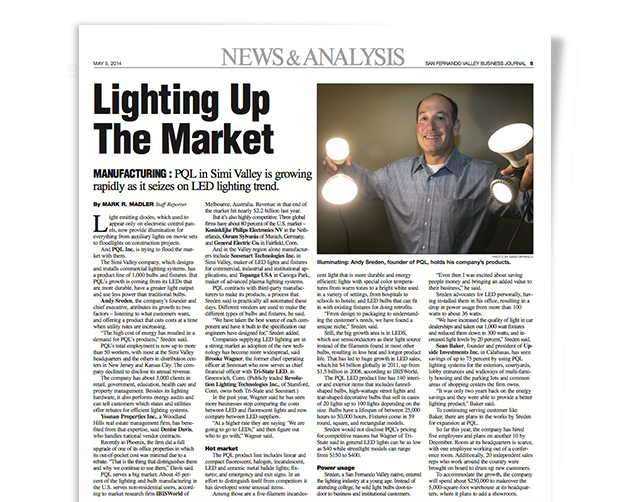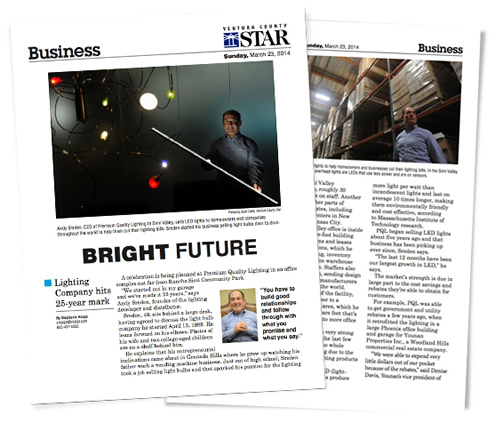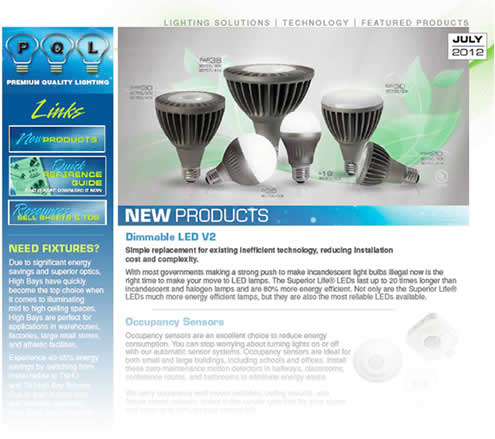
Featured article in the San Fernando Valley Business Journal

PQL hits 25-year mark! Featured article in the Ventura County Star

PQL News : July

New 2012 Standards for General Service Fluorescent Lamps (GSFL)
Effective Date of new DOE standards: July 14, 2012
Current exemptions continue [For example, lamps with CRI .87, cold temp. (CT), UV, etc.]
Impact for 4f & 8 e Fluorescents Lamps . 4500K and > 4,500K and . 7,000K<
T12 4-ft. & 2-ft U-lamps with medium bi-pin bases
- Majority of F40 and F34T12 lamps and all FB40 and FB34T12 U-lamps FAIL.
- 4-ft. requires 3560 lumens @ 40W and 3030 lumens @ 34W to pass @ 89 LPW.
- 2-ft. U-lamps require 3360 @ 40W and 2856 @ 34W to pass @ 84 LPW.
- CWX/DX/DSGN50/C50 are exempt due to CRI.
T12 8-ft. Slimline with single pin bases
- All 75W F96T12 lamps FAIL.
- All 60W F96T12/ES FAIL except for the 800/SPX Series & some 700/SP long life Series.
- CWX/DX/DSGN50/C50 are exempt due to CRI.
T12 8-ft. 800mA HO with RDC bases
- All 110W F96T12 HO lamps FAIL. Requires enhanced coatings with 10,120 lumens to pass.
- All 95W F96T12/ES/HO FAIL except for enhanced 800 Series. Requires 8740 lumens to pass.
- CWX/DX/DSGN50/C50 are exempt due to CRI; CW/CT & D/CT are exempt.
T8 4-ft. & 2-ft. U-lamps with medium bi-pin bases
- All 4-ft. T8 basic 700/SP Series lamps @ 2800 lumens FAIL. Requires 2850 lumens to pass.
- All other 4-ft. pass.
- All 2-ft. 800/SPX Series U-lamps pass. Some 700/SP Series pass.
T8 8-ft. Slimline with single pin bases
- All pass except some 700/SP Series. Requires 5723 lumens @ 59W to pass.
T8 8-ft. HO with RDC bases
- All pass except some 700/SP Series. Requires 7912 lumens @ 86W to pass.
T5 4-ft with miniature bi-pin bases
- All pass
Lumens, CFLs and LEDs: A light bulb guide for new regulations
(ARA) - You've probably been hearing the talk of federal light bulb regulations for years, but in January 2012, the talk will become reality, and these regulations will begin to take effect. While California residents began the transition in January 2011, the federally mandated phase-out of less efficient incandescent light bulbs begins with the 100-watt light bulb on Jan. 1, 2012, so now is the time for the rest of the country to make the switch to more efficient bulbs.
Before you begin considering your options, here's a quick review of how the new regulations will work:
- Incandescent, or traditional, 100-watt light bulbs for general purpose, household shape lamps will no longer be available in stores beginning January 2012. Retailers will be able to sell-through any existing inventory, but the traditional 100-watt incandescent bulbs will not be replaced on the shelf.
- Incandescent 75-watt light bulbs will be unavailable in 2013.
- Incandescent 40-watt and 60-watt light bulbs will be phased out in 2014.
Learning about lumens
As we transition away from incandescent bulbs, the lingo used to describe the brightness of the light bulbs is changing. We've become accustomed to identifying the brightness of a light bulb by the amount of power - watts - that it uses. However, more efficient light bulbs emit the same amount of light - measured in lumens - while using less electricity.
For example, the following light bulbs all produce roughly the same amount of light (450 lumens): 40-watt incandescent, 29-watt halogen, 11-watt compact fluorescent (CFL) and 9-watt LED. It's still important to pay attention to wattage to make sure you don't exceed the recommended level for your lamp, but it's increasingly unlikely that you'll exceed that level as you purchase more efficient bulbs.
Types of bulbs available
As you move on from incandescent bulbs, you'll want to familiarize yourself with the different types of more energy-efficient bulbs available. These bulbs will consume less energy and last longer, saving you money on monthly utility bills.
Compact fluorescent: CFL bulbs are more expensive than incandescent bulbs, but use up to 75 percent less energy and last up to 10 times as long, making it easy for you to quickly recoup the money you spend on them. You can save up to $70 per year by placing CFLs in your five most commonly used lamps, according to theEnvironmental Protection Agency. You've likely seen them in spiral or tube-like shapes, but CFLs also come in the A-line form common in most incandescent bulbs.
Halogen: These bulbs use the same technology as incandescent bulbs but last up to three times longer and are about 50 percent more efficient. Halogens are known for producing the highest quality light but aren't as efficient as CFLs. When changing halogens, you'll want to make sure you use a rag because oil from your skin can reduce the bulb's longevity.
LED: LED bulbs take the efficiency and durability of CFLs even further, as this bulb is rated to last more than 22 years and uses slightly less energy than a CFL bulb that also produces 450 lumens.
China will phase out energy-draining light bulbs
BEIJING (AP) — China will phase out power-draining light bulbs within five years in a move to make the world's biggest polluting nation more efficient but also certain to impact the global market.
China will ban imports and sales of 100-watt-and-higher incandescent bulbs from Oct. 1, 2012, in an attempt to save energy and curb climate change, China's main planning agency said Friday.
Bans will also be imposed on 60-watt-and-higher bulbs from Oct. 1, 2014 and 15-watt-and-higher old-style bulbs from Oct. 1, 2016. The time frame of the last step may be adjusted according to an evaluation in September 2016, the National Development and Reform Commission statement said.
State-run Xinhua News Agency quoted Xie Ji, deputy director of the NDRC's environmental protection department, as saying China is the world's largest producer of both energy-saving and incandescent bulbs and so the plan will also "have a significant impact" in reducing the use of incandescents worldwide.
Last year, 3.85 billion incandescent light bulbs were produced in China and 1.07 billion of them were sold domestically, the agency said. Power consumption for lighting is estimated to be about 12 percent of China's total electricity use, it said.
The statement said China will save 48 billion kilowatt hours of power per year and reduce emissions of carbon dioxide by 48 million tonnes annually once the bulbs are phased out.
Several countries plan to phase out traditional light bulbs. The United States will ban the making and sale of incandescent light bulbs beginning in 2012. The 27-nation European Union agreed in 2008 to phase out the bulbs by 2012.
Lighting Industry Transformations to Affect Californians before the rest of the US
California becomes a test lab next year for how consumers nationwide may react to new federal lighting efficiency laws taking effect throughout the country on January 1, 2012. Under Title 20, the Golden State's energy commission has the authority to regulate lighting products used by consumers and businesses.
As a result of the commission's actions, consumers in California will start to experience the phase out of the 100-watt incandescent light bulb this coming January, a year before the rest of the country. Californians will also deal with the phasing out of 75-watt, 60-watt and 40-watt incandescent bulbs on an accelerated schedule.
News Archive
2014
2013
2012
2011
2010
2009
Phone: 1.800.323.8107 • Fax: 1.877.619.7053
Copyright © 2025 - P.Q.L., Inc. - All Rights Reserved.